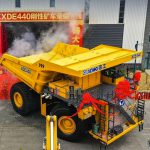
Chrome miners look to drones to improve security
Chrome Miners Association chairperson Shelton LucasZimbabwe has the world’s second largest known chrome deposits with about 900 million tonnes of untapaped ore against total world reserves estimated to be 10 billion tonnes.
Only South Africa has more chrome ore reserves than Zimbabwe.Chrome is mainly mined along the Great dyke of Zimbabwe and occurs as seam or stratiform deposits. It is mainly used in stainless steel production, as a metal coat, in the chemical industry and in metallurgical processes.
Export earnings from chrome remain a large contributor to the economy. Zimbabwe is targeting to be producing 100 tonnes of gold per year by 2023, which is part of a drive to achieve export earnings of US$12 billion by the mining sector by that time.
Of the US$12 billion, gold, platinum diamonds will contribute US$4 billion, US$3 billion and US$1 billion respectively. Chrome, iron ore and carbon steel will contribute US$$1 billion while coal and hydrocarbons will contribute the same. Lithium at US$500 000 while other minerals will constitute US$1.5 billion.
Some of the big players in the chrome business include Zimasco and Chinese companies. Our reporter Almot Maqolo (AM) caught up with Chrome Miners Association chairperson Shelton Lucas to discuss some of the risks involved in the industry.
Here is how their discussion turned out…
AM: How has the pandemic affected your operations?
SL: The pandemic has affected chrome operations globally from last year since the first lock down globally there was a decline in demand that subsequently led to a sharp fall in prices of chrome. The costs of extraction of chrome and logistics were now outstripping the value of the cargo.
AM: Tell us about the security situation in your operations?
SL: ln every mine set up there are security concerns but in terms of pilferage of chrome, it is very minimum because of its quantitative nature. However, it can be stolen through overloading of trucks by workers or over a long period of time in perpetuity where some people will be stealing small stockpiles and stockpiling somewhere until they consolidate to a meaningful load.

AM: How can this be improved?
SL: This can be improved by use of drones and spy cameras at the mines, installation of weighbridges at the mines and purchase of X-ray fluorescent machines that can quantify the minerals in the ore. This is in the sense that each load has got different weights on the same volume. Due to different mineral compositions in different rocks you will find that 44% content is heavier than 42% chrome.
AM: How has automation affected your business?
SL: There has been automation on the extraction side and loading side but on the grading side it’s still manual.
AM: The country has experienced mine disasters and claimed lives of artisanal miners. Are mining companies following safety laws?
SL: Mining companies have adopted safety health and environment which is safety, health and environment and it is within those guidelines that they are bound to exercise safety. However there are some workings which would have been in progress where some of the accidents happen where some people come after normal working hours and they might fall into pits. If cross checked most of the people who lose their lives are illegal miners on a legal set up.
AM: How are mining companies handling fraud and corruption issues?
SL: Mining companies are handling fraud and corruption cases through the engagement of the Criminal Investigation Department division of mines and minerals. However in most corruption cases most cases lack evidence because corruption involves many parties so it’s a bit intricate.


